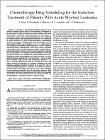| dc.contributor.author | Panoskaltsis, Nicki | |
| dc.date.accessioned | 2024-01-18T10:21:08Z | |
| dc.date.available | 2024-01-18T10:21:08Z | |
| dc.date.issued | 2014 | |
| dc.date.submitted | 2014 | en |
| dc.identifier.citation | Pefani E., Panoskaltsis N., Mantalaris A., Georgiadis M.C., Pistikopoulos E.N., Chemotherapy drug scheduling for the induction treatment of patients with acute myeloid leukemia, IEEE Transactions on Biomedical Engineering, 61, 7, 2014, 2049 - 2056 | en |
| dc.identifier.issn | 15582531 00189294 | |
| dc.identifier.other | Y | |
| dc.identifier.uri | http://hdl.handle.net/2262/104397 | |
| dc.description | PUBLISHED | en |
| dc.description.abstract | Leukemia is an immediately life-threatening cancer
wherein immature blood cells are overproduced, accumulate in
the bone marrow (BM) and blood and causes immune and blood
system failure. Treatment with chemotherapy can be intensive or
nonintensive and can also be life-threatening since only relatively
few patient-specific and leukemia-specific factors are considered
in current protocols. We have already presented a mathematical
model for one intensive chemotherapy cycle with intravenous (IV)
daunorubicin (DNR), and cytarabine (Ara-C) [1]. This model is
now extended to nonintensive subcutaneous (SC) Ara-C and for a
standard intensive chemotherapy course (four cycles), consistent
with clinical practice. Model parameters mainly consist of physio-
logical patient data, indicators of tumor burden and characteristics
of cell cycle kinetics. A sensitivity analysis problem is solved and
cell cycle parameters are identified to control treatment outcome.
Simulation results using published cell cycle data from two acute
myeloid leukemia patients [2] are presented for a course of stan-
dard treatment using intensive and nonintensive protocols. The
aim of remission–induction therapy is to debulk the tumor and
achieve normal BM function; by treatment completion, the total
leukemic population should be reduced to at most 109 cells, at
which point BM hypoplasia is achieved. The normal cell number
should be higher than that of the leukemic, and a 3-log reduction
is the maximum permissible level of population reduction. This
optimization problem is formulated and solved for the two patient
case studies. The results clearly present the benefits from the use
of optimization as an advisory tool for treatment design. | en |
| dc.format.extent | 2049-2056 | en |
| dc.format.extent | 2049 | en |
| dc.format.extent | 2056 | en |
| dc.language.iso | en | en |
| dc.relation.ispartofseries | IEEE Transactions on Biomedical Engineering; | |
| dc.relation.ispartofseries | 61; | |
| dc.relation.ispartofseries | 7; | |
| dc.rights | Y | en |
| dc.subject | Pharmacokinetics | en |
| dc.subject | Pharmacodynamics | en |
| dc.subject | Cell cycle models | en |
| dc.subject | Chemotherapy optimization | en |
| dc.subject | Mathematical modelling | en |
| dc.title | Chemotherapy drug scheduling for the induction treatment of patients with acute myeloid leukemia | en |
| dc.type | Journal Article | en |
| dc.type.supercollection | scholarly_publications | en |
| dc.type.supercollection | refereed_publications | en |
| dc.identifier.peoplefinderurl | http://people.tcd.ie/panoskan | |
| dc.identifier.rssinternalid | 261387 | |
| dc.identifier.doi | http://dx.doi.org/10.1109/TBME.2014.2313226 | |
| dc.rights.ecaccessrights | openAccess | |
| dc.identifier.orcid_id | 0000-0001-8972-5697 | |




